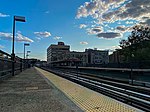Robert K. Kraft Field at Lawrence A. Wien Stadium
1984 establishments in New York CityAmerican football venues in New York CityAthletics (track and field) venues in New York CityCollege football venuesCollege lacrosse venues in the United States ... and 10 more
College soccer venues in the United StatesCollege track and field venues in the United StatesColumbia Lions footballColumbia UniversityInwood, ManhattanLacrosse venues in New York CitySoccer venues in New York CitySports venues completed in 1984Sports venues in ManhattanU.S. Route 9

Robert K. Kraft Field at Lawrence A. Wien Stadium, officially known as Robert K. Kraft Field at Lawrence A. Wien Stadium at Baker Athletics Complex, is a stadium in the Inwood neighborhood at the northern tip of the island of Manhattan, New York City. Part of Columbia University's Baker Athletics Complex, it is primarily used for American football, lacrosse, and track and field events. The stadium opened in 1984 and holds 17,100 people.
Excerpt from the Wikipedia article Robert K. Kraft Field at Lawrence A. Wien Stadium (License: CC BY-SA 3.0, Authors, Images).Robert K. Kraft Field at Lawrence A. Wien Stadium
West 218th Street, New York Manhattan
Geographical coordinates (GPS) Address External links Nearby Places Show on map
Geographical coordinates (GPS)
| Latitude | Longitude |
|---|---|
| N 40.873224 ° | E -73.916452 ° |
Address
Robert K. Kraft Field
West 218th Street
10034 New York, Manhattan
New York, United States
Open on Google Maps









